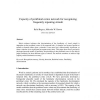Free Online Productivity Tools
i2Speak
i2Symbol
i2OCR
iTex2Img
iWeb2Print
iWeb2Shot
i2Type
iPdf2Split
iPdf2Merge
i2Bopomofo
i2Arabic
i2Style
i2Image
i2PDF
iLatex2Rtf
Sci2ools
IJON
2002
2002
Capacity of perirhinal cortex network for recognising frequently repeating stimuli
Much evidence indicates that discrimination of the familiarity of visual stimuli is dependent on the perirhinal cortex of the temporal lobe. A stimulus can become familiar to animals or humans either when a stimulus is seen once but is behaviourally significant, or when a stimulus is not significant but repeats many times. This paper shows that a previously developed network model of familiarity discrimination in the perirhinal cortex is also able to judge familiarity for these different types of stimuli. The network continues to achieve high capacity and discriminative accuracy.
| Added | 22 Dec 2010 |
| Updated | 22 Dec 2010 |
| Type | Journal |
| Year | 2002 |
| Where | IJON |
| Authors | Rafal Bogacz, Malcolm W. Brown |
Comments (0)

